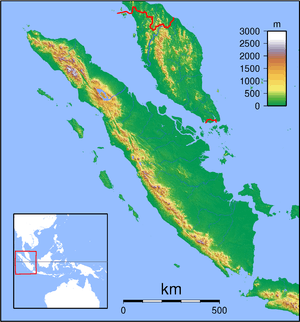Tesso Nilo National Park
| Tesso Nilo National Park | |
|---|---|
|
IUCN category II (national park) | |
 | |
 Tesso Nilo NP Location in Sumatra | |
| Location | Sumatra, Indonesia |
| Coordinates | 0°5′S 101°36′E / 0.083°S 101.600°ECoordinates: 0°5′S 101°36′E / 0.083°S 101.600°E |
| Area | 1000 km2 |
| Established | 2004 |
| Governing body | Ministry of Forestry |
Tesso Nilo National Park is a national park in Riau Province, Sumatra, Indonesia. It was declared a national park by the Indonesian government in 2004.[1] The original area of the park was 385.76 km2, but the decision has been made to expand it to 1000 km2.[2] Tesso Nilo National Park houses some of the largest coherent lowland rainforests remaining on Sumatra. The Center for Biodiversity Management has surveyed over 1,800 plots in tropical forests around the world. They found that no other plot has as many vascular plants as in Tesso Nilo. Indonesian Institute of Sciences (LIPI) surveyed forests throughout Sumatra, and also found that Tesso Nilo housed by far the most species.
Flora and fauna
Critically endangered Sumatran elephants and Sumatran tigers live here.
Conservation and threats
The park suffers heavy encroachment from illegal loggers and illegal settlers who clear the park for crops and palm oil plantations, as well as village sites. Already, 28,600 hectares, or about a third of the park, has been deforested. In November 2009, WWF announced that the park had finally been expanded by 44,492 hectares [3] but encroachment still remains a serious problem.
According to a WWF report published in June 2013, oil palm plantations cover 36,353 ha of the Tesso Nilo forest complex, with two business groups (Asian Agri and Wilmar Groups) being involved in the trade of the oil palm fruit illegally grown inside the national park. Furthermore, 50 mills operating around the Tesso Nilo forest complex were identified. [4]
During drought periods, the forest is susceptible to wildfires. In the October 2006 fires, 1 km2 of the park was burnt.[5] According to 2009 WWF survey, the population of Sumatran elephants had reached 200 in the park, and around 350 elephant in Riau Province.[6]
Elephant conservation centre
The Belgian government committed to provide 200,000 euros in assistance for the construction of a Sumatran elephant conservation centre in the Tesso Nilo National Park, with the first quarter to be disbursed in 2011. The project will fund the relocation of dozens of tame elephants from Minas in Siak district, to Tesso Nilo. The relocation was justified by the loss of habitat in Minas due to oil palm plantations and oil mining.[7]
In 2012, the elephant population in the park is estimated 120 to 150 elephants through samples of elephant dropping. For three months, starting late of June, Deoxyribonucleic acid (DNA) of elephants's faeces are being conducted to get the actual number of elephants.[8]
See also
References
- ↑ "Indonesia Declares Tesso Nilo National Park". Archived from the original on 2007-11-10. Retrieved 2007-09-30.
- ↑ "Government Announces Expansion of Tesso Nilo National Park to Ensure Room for Sumatran Elephants". WWF. Archived from the original on 2007-11-27. Retrieved 2007-09-30.
- ↑ "WWF-Indonesia Sambut Keputusan Dephut Perluas TN Tesso Nilo" (PDF). WWF. Retrieved 2010-04-08.
- ↑ Palming Off a National Park - Tracking Illegal Oil Palm Fruit in Riau, Sumatra (Report). WWF. 2013. p. 3.
- ↑ Tan, Tania. "Unhealthy air quality may last for a few weeks". The Straits Times. Singapore Press Holdings. p. 1.
- ↑ Aditia Maruli: Elephant in Tesa Nilo national park delivers baby in Antara News, February 1, 2011
- ↑ Antara News, retrieved 4 February 2011
- ↑ "Elephant population research in Riau uses DNA technology". July 24, 2012.